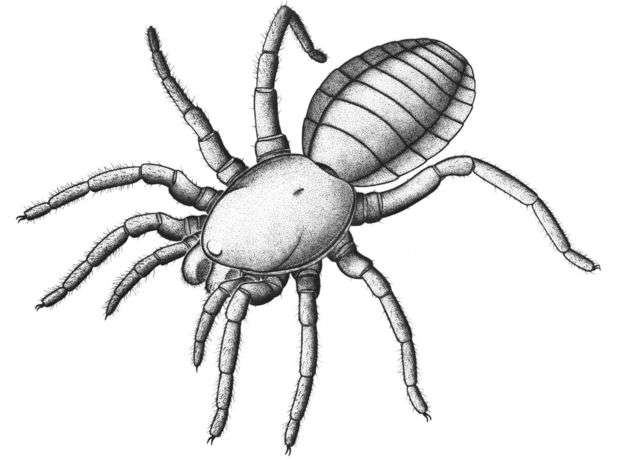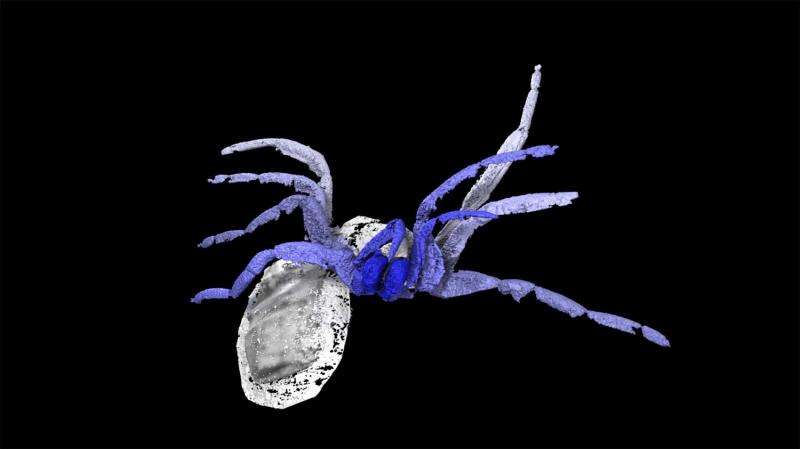March 30, 2016 report
Ancient fossil marks bridge between early arachnids and modern spiders

(Phys.org)—A team of researchers from the U.S., Germany and the U.K. has used modern technology to reveal the true nature of an ancient arachnid. In their paper published in Proceedings of the Royal Society B the team describes the ancient creature as "almost a spider."
Back in the 80's a team of researchers discovered a host of fossils in a part of what is now eastern France, but at least one of them was only partly visible because the rest of its body was encased in ironstone. Because attempting to remove the dense opaque stoneware would have destroyed the fossil, researchers simply put it in a drawer and waited for technology to develop that would allow for examining the fossil while still inside the stone. In this new effort, the researchers have used technology similar to medical CT scans to allow for creating 3D imagery of the fossil and in so doing have added another piece to the puzzle of how spiders evolved.
The fossil, named Idmonarachne brasieri was dated to approximately 305 million years ago, putting it before the dinosaurs, and it resembles modern spiders in many ways, but is missing one critical part: an organ for spinning silk. The fossil also did not have a tail-like appendage, which has been found on other arachnids of nearly the same time period, which suggested that it was a unique species, one that is believed to have gone extinct as its cousins continued to evolve into modern spiders. Because of its age and body structure, the specimen is helping scientists learn more about the manner in which spiders evolved. They believe it is one of the closet relatives without actually being a true spider. The 1.5cm arachnid was also found to have impressive jaws, which further helped prove it was a unique species.

To make sure that the fossil did not have spinnerets, necessary for spinning silk, that were simply missing, the fossil was also examined by use of a Diamond synchrotron—it makes use of high-powered X-rays to see tiny objects more clearly. The team found no evidence of a hole left behind in the abdomen where anything might have fallen off, showing that the arachnid was indeed a relative, and not an actual early spider.
More information: Russell J. Garwood et al. Almost a spider: a 305-million-year-old fossil arachnid and spider origins, Proceedings of the Royal Society B: Biological Sciences (2016). DOI: 10.1098/rspb.2016.0125
Abstract
Spiders are an important animal group, with a long history. Details of their origins remain limited, with little knowledge of their stem group, and no insights into the sequence of character acquisition during spider evolution. We describe a new fossil arachnid, Idmonarachne brasieri gen. et sp. nov. from the Late Carboniferous (Stephanian, ca 305–299 Ma) of Montceau-les-Mines, France. It is three-dimensionally preserved within a siderite concretion, allowing both laboratory- and synchrotron-based phase-contrast computed tomography reconstruction. The latter is a first for siderite-hosted fossils and has allowed us to investigate fine anatomical details. Although distinctly spider-like in habitus, this remarkable fossil lacks a key diagnostic character of Araneae: spinnerets on the underside of the opisthosoma. It also lacks a flagelliform telson found in the recently recognized, spider-related, Devonian–Permian Uraraneida. Cladistic analysis resolves our new fossil as sister group to the spiders: the spider stem-group comprises the uraraneids and I. brasieri. While we are unable to demonstrate the presence of spigots in this fossil, the recovered phylogeny suggests the earliest character to evolve on the spider stem-group is the secretion of silk. This would have been followed by the loss of a flagelliform telson, and then the ability to spin silk using spinnerets. This last innovation defines the true spiders, significantly post-dates the origins of silk, and may be a key to the group's success. The Montceau-les-Mines locality has previously yielded a mesothele spider (with spinnerets). Evidently, Late Palaeozoic spiders lived alongside Palaeozoic arachnid grades which approached the spider condition, but did not express the full suite of crown-group autapomorphies.
Journal information: Proceedings of the Royal Society B
© 2016 Phys.org





















